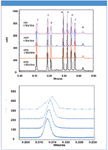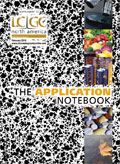30-s UHPLC Separation of Pharmaceutical Ingredients Using PDA Detection
Ultra fast separations of acetaminophen, caffeine, propofol, and parabens are achieved in 30 s using the Accelaâ„¢ UHPLC system with the 80 Hz PDA detector.
Guifeng Jiang, Yenny Chan, and Andre J. Nohl, Thermo Fisher Scientific, Inc.
Ultra fast separations of acetaminophen, caffeine, propofol, and parabens are achieved in 30 s using the Accela™ UHPLC system with the 80 Hz PDA detector. The performance of the PDA detector is highlighted by its low noise level, low drift, four orders of magnitude linear working range, and high sensitivity.
Results
Detector Noise and Drift
The drift was measured at flow rate of 1000 μL/min with a constant flow of 100% methanol. The drift value for the PDA detector was 0.1 mAU/h.
The reduction in the level of noise increased detector sensitivity. The level of noise of the PDA detector was lower when the detector was operated at lower data sampling rates and/or higher rise times. The levels of noise of four different data rates (5, 20, 40, and 80 Hz) were 1.1, 4.5, 14.8, and 43.1 μAU, respectively.
Data Sampling Rate Optimization
In general, about 20 data points per peak is required for reproducible quantitation. High data sampling rates resulted in increased noise reducing sensitivity. Eight pharmaceutical small molecules were separated in 30 s utilizing LC gradient method I and a BDS 50 × 4.6 mm column with elution order of uracil, acetaminophen, caffeine, methylparaben, ethylparaben, propylparaben, butylparaben, and propofol (Figure 1). Similar peak width and peak resolution were obtained with 40 Hz and 80 Hz data sampling rates, indicating that both rates were suitable for this chromatographic separation. The 40 Hz data sampling rate was preferred here for its lower noise level and better sensitivity.

Figure 1: The high speed separation of pharmaceutical ingredients in 30 s with data sampling rate of 5, 20, 40, and 80 Hz.
Detector Linearity and Sensitivity
High throughput UHPLC completes separations in tens of seconds and improves sensitivity resulting in sharper, taller, and better resolved peaks.
Calibration curves of the four compounds were constructed over the concentration range of 39–300,000 ng/mL with 11 calibration levels. Correlation coefficients were achieved 0.999 or better for all four compounds with four orders of magnitude linearity working range.
Conclusions
The Accela PDA detector acquires data at sampling rates up to 80 Hz for UHPLC high throughput separations with independent setting of diode rates, data sampling rates, and rise time. Using the current UHPLC instrumentation and sub-2 μm particle columns, the PDA detector provided sufficient data point to define a chromatographic peak with peak width as narrow as 0.166 s. The four orders of magnitude linear working range and the ppb (ng/mL) level sensitivity for the PDA detector ensured the low level determination and quantification of the target compounds in UHPLC high throughput analyses.

Thermo Fisher Scientific, Inc.
2215 Grand Avenue Parkway, Austin, TX 78728
tel. (800)532-4752; fax (561)688-8731
Website: www.thermo.com

SEC-MALS of Antibody Therapeutics—A Robust Method for In-Depth Sample Characterization
June 1st 2022Monoclonal antibodies (mAbs) are effective therapeutics for cancers, auto-immune diseases, viral infections, and other diseases. Recent developments in antibody therapeutics aim to add more specific binding regions (bi- and multi-specificity) to increase their effectiveness and/or to downsize the molecule to the specific binding regions (for example, scFv or Fab fragment) to achieve better penetration of the tissue. As the molecule gets more complex, the possible high and low molecular weight (H/LMW) impurities become more complex, too. In order to accurately analyze the various species, more advanced detection than ultraviolet (UV) is required to characterize a mAb sample.















